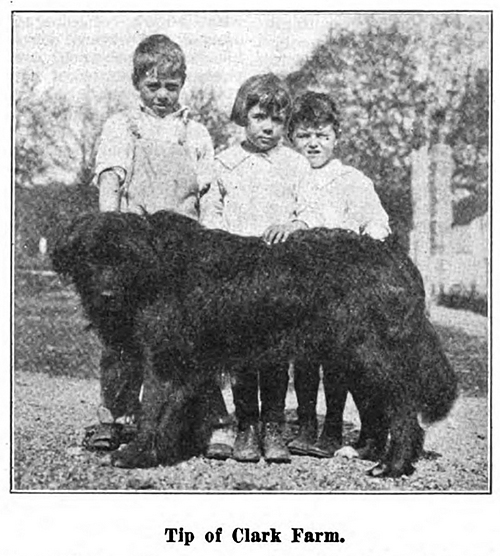[ The Dog Fancier ]
This American magazine (Battle Creek, MI) began publication in 1891.
The December, 1917, issue's breed column on the Newfoundland considers the waning popularity of the breed:
Very few Newfoundlands are seen at the present time. When we recollect how common they were thirty or more years ago, it seems strange that they disappeared, for everyone over thirty years of age surely remembers many of them, and invariably they were smart in every way. Courageous at all times, the boss of their district, and the protector of the small dogs and children nearby. Mr. Clark writes: I remember many individual dogs, one owned by a boatman on the Passaic river. The owner of this dog had his work on the other side of the river from his home, and every noonetime this dog took his dinner pail over a nearby bridge to his master, also taking the empty pail back home. I remember another that used to carry a large basket by the teeth, two children going with him would fill it with wood, the dog carrying it home. Thirty years ago my brother and I had a fine Newfoundland that we trained to draw a wagon, and in winter a sled. He was as fast with the sled on a half mile run as a good horse with cutter, and many races we had with him. I remember one all white Newfoundland of thirty years ago and have a photo of him. This dog did not have any black on him — very unusual. The Landseer type should have black head with white markings, or at least black ears. Forty years ago at the Madison Square Garden show they had twelve entries, and four years later twenty-five. Entries were very good until about twenty years ago. The last ten years we have rarely seen any in the shows. I know of some seventeen very fine ones imported by six breeders and these breeders have not exhibited except one or two times, as they do not wish to bring distemper or pneumonia to their kennels. We have today just as fine specimens in the United States as can be found anywhere. The photo of Tip of Clark Farm, A. K. C. 229,633, well shows the quality of the present day Newfoundland. As to color we see more of the black ones, but of the seventeen imported ones, some were the "Landseer's" — white and balck, and they are as fine as the finest. Two very fine Landseers were shown at Madison Square Garden a few years ago. — Josiah H. Clark, Boonton, N. J. (13)
This column was accompanied by the following image (which was published in Dogdom two months earlier to accompy a note by Clark responding to an article about Newfoundlands in that magazine in September):
The November, 1917, issue of this magazine carried, as its very brief "Newfoundland" column, a preview notice regarding the above article:
J. H. Clark of Boonton, N. J., sends us a photo of his Newfoundland dog, Tip of Clark Farm, A. K. C. 229633, and some of the dog's companions, he being an especial favorite with all the boys in that neighborhood. Tip is a splendid guard dog, taking care of all the stock on the farm. He was bred and raised by Mr. Clark and the photo above shows him to be a good typical specimen. Mr. Clark, who has also been breeding Collies, has decided to dispose of them and give the room to his Newfoundlands. (9)
Yet "Tip" was not Mr. Clark's first Newfoundland; click here for an earlier note in this magazine regarding Clark's Newf-breeding efforts.
The idea that the Newfoundland was a vanishing breed was touched on in a surprising number of magazine articles and books in the early years of the 20th Century. For discussion of the idea, see this article here at The Cultured Newf.

